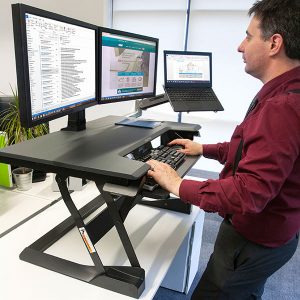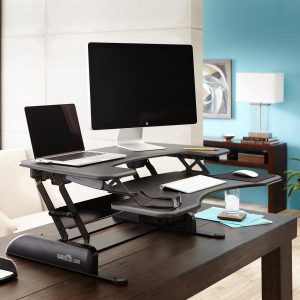
There has been a lot of hype in recent years stating that “sitting is the new smoking” which is beyond frightening when we consider the sedentary nature of so many occupations. There is definitely backing to this claim – the amount of time spent sitting has been conclusively linked to heart disease, Type 2 Diabetes, lung disease, depression, some cancers (bowel and breast) & obesity. These are the longer term, gradual effects of sitting. However, most of the issues we see here in the clinic are the musculoskeletal problems that arise – lower back pain, upper back pain, neck pain, headaches, rounding shoulders & poked neck postures, none of which feel good or look good! Other concerns are the effects that prolonged sitting can have on the metabolic system, the increase in mental fatigue & the impact on work productivity.
Surprisingly, research also shows that prolonged sitting, with absence of movement over a long period of time, has negative health effects regardless of the amount of physical activity you do at other times. We recommend 2 minutes of exercise every 20 minutes to lower glucose levels & reverse the negative effects of sitting. The exercise need not be high intensity; a walk around the office for 2 minutes will suffice. A good trick we often recommend to clients is to have a water glass or a very small water bottle on their desk within eyesight. Not only will this encourage good daily water intake, it also gives you a reason to get up from your desk to move regularly, whether it be to refill your glass or go to the bathroom!
Unfortunately there are downsides to standing for long periods of time too. These include lower back & knee, leg or foot pain, fatigue & cardiovascular problems which come about not only because of the static nature of standing, but also because of the poor postures adopted during that time standing. If you are standing for long periods, you may need extra interventions to assist, eg. shoe inserts, compression stockings & anti-fatigue mats.
After all that you may be thinking you’d be better off standing up, walking around the office, walking right out the door & never coming back! If only!
However, there is a good way to manage your time so you can sit AND stand to improve your musculoskeletal woes, energy levels and productivity, & reduce the negative medical effects on metabolic rate & blood sugar levels.
So the question arises…should I get a standing desk? Should I stand all the time? When I stand for too long, my back & legs get sore & tired…Am I standing incorrectly?

The guidelines for sitting & standing times are under constant review as more research becomes available on the topic. Recent studies advocate for workers to aim to accumulate 2 hours a day of standing & walking during work hours, before eventually progressing to a total of 4 hours per day. To start out, we recommend standing for 15-20 minutes of each hour, to equate to 2 hours of the working day.
We also recommend:
– Breaks every 20-30 minutes
– Task variety – in the type of work & the mental and postural demands
– Frequent short walks, rather than infrequent longer breaks
Some workplaces & managers are concerned by the frequency of these mini-breaks. However, recent studies show a positive effect on reducing discomfort in all musculoskeletal areas, with no detrimental effect on worker productivity.
Many workplaces require a letter from a physiotherapist explaining the need for sit-to-stand desks or recommendations for regular breaks. We are more than happy to write this up if we feel either would benefit you.
Once getting a sit-stand desk it is vital to have it set up correctly to suit your body type & size, both in the standing position & sitting position. Many workplaces have someone who can perform ergonomic assessments to determine the ideal desk for your available space & assist in the setup once a desk is purchased. There are also occupational health or ergonomic physiotherapists that you can seek help from.
Sit-to-stand desks have occasionally been installed but not utilised effectively. This may be because they are physically difficult to adjust, the users do not like to stand, or the adjustment of the desk is difficult & therefore contributing to musculoskeletal injuries. It is therefore important to have the desk set up well for your body.
Key features for correct sitting postures:
– feet flat on the ground or onto a footstool
– knees & hips at right angles
– support through the lower back, either from the chair itself, or from a lumbar cushion
– elbows set up at right angles – adjust the chair or desk height to achieve this
Key features for correct standing postures:
– even weight distribution through both legs
– avoid leaning into one hip
– have your weight spread evenly through heel & forefoot
– have your elbow/hand levels 90 degrees
– setup your screen so the top of the screen corresponds with eye height
Click here for a PDF of the IDEAL SITTING POSTURE. Feel free to pass this on to your colleagues!


